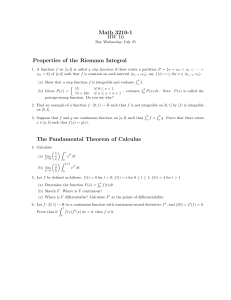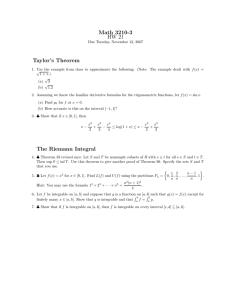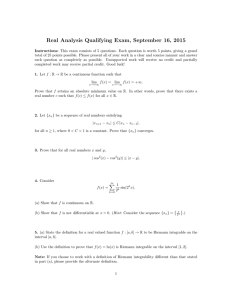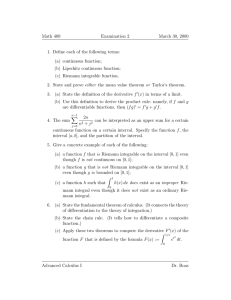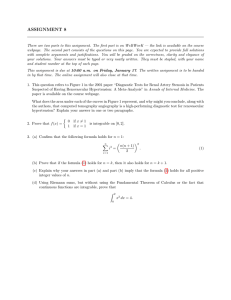Problem 1. If f(x) = ∫ g(t)dt where a(x) and b(x) are C 1 functions
advertisement
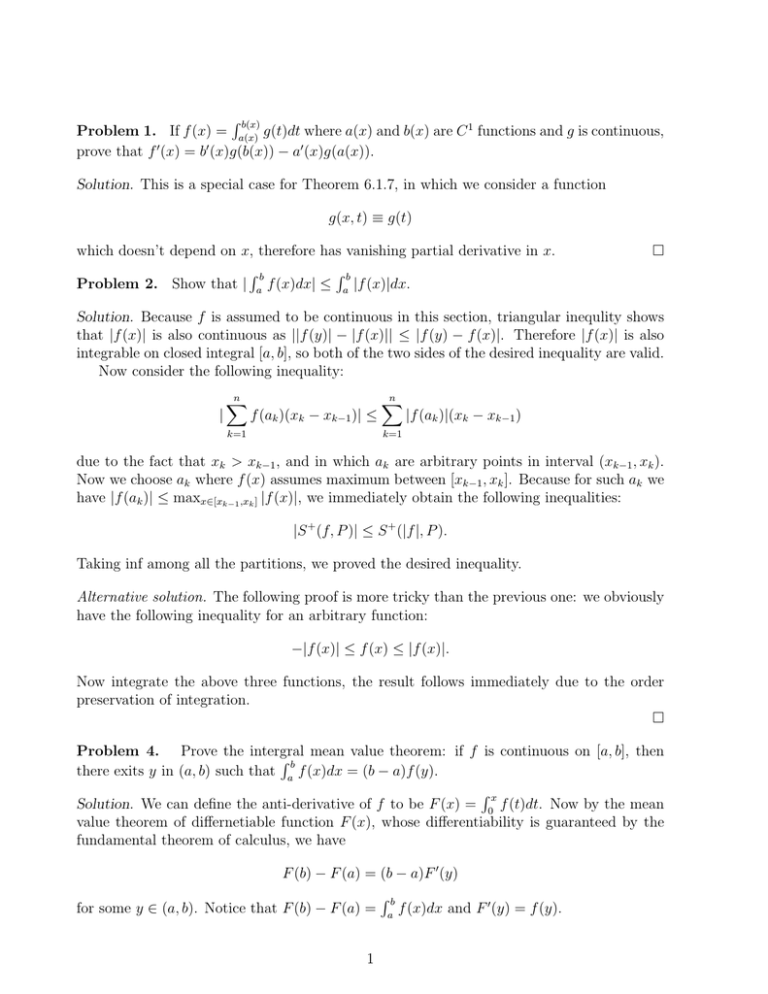
R b(x) Problem 1. If f (x) = a(x) g(t)dt where a(x) and b(x) are C 1 functions and g is continuous, prove that f 0 (x) = b0 (x)g(b(x)) − a0 (x)g(a(x)). Solution. This is a special case for Theorem 6.1.7, in which we consider a function g(x, t) ≡ g(t) which doesn’t depend on x, therefore has vanishing partial derivative in x. Rb Rb Problem 2. Show that | a f (x)dx| ≤ a |f (x)|dx. Solution. Because f is assumed to be continuous in this section, triangular inequlity shows that |f (x)| is also continuous as ||f (y)| − |f (x)|| ≤ |f (y) − f (x)|. Therefore |f (x)| is also integrable on closed integral [a, b], so both of the two sides of the desired inequality are valid. Now consider the following inequality: | n X f (ak )(xk − xk−1 )| ≤ k=1 n X |f (ak )|(xk − xk−1 ) k=1 due to the fact that xk > xk−1 , and in which ak are arbitrary points in interval (xk−1 , xk ). Now we choose ak where f (x) assumes maximum between [xk−1 , xk ]. Because for such ak we have |f (ak )| ≤ maxx∈[xk−1 ,xk ] |f (x)|, we immediately obtain the following inequalities: |S + (f, P )| ≤ S + (|f |, P ). Taking inf among all the partitions, we proved the desired inequality. Alternative solution. The following proof is more tricky than the previous one: we obviously have the following inequality for an arbitrary function: −|f (x)| ≤ f (x) ≤ |f (x)|. Now integrate the above three functions, the result follows immediately due to the order preservation of integration. Problem 4. Prove the intergral mean value theorem: if f is continuous on [a, b], then Rb there exits y in (a, b) such that a f (x)dx = (b − a)f (y). Rx Solution. We can define the anti-derivative of f to be F (x) = 0 f (t)dt. Now by the mean value theorem of differnetiable function F (x), whose differentiability is guaranteed by the fundamental theorem of calculus, we have F (b) − F (a) = (b − a)F 0 (y) for some y ∈ (a, b). Notice that F (b) − F (a) = 1 Rb a f (x)dx and F 0 (y) = f (y). Alternative solution. We can also use the intermediate value property of the continuous function f (x). In fact because we have the following obvious inequality: Rb m≤ a f (x)dx ≤M b−a in which m is the minimum of f over [a, b] and similarly M is theR maximum. So there must b Rb f (x)dx be a point y ∈ (a, b) such that f (y) = a f (x)dx/(b − a), if m < a b−a < M . Furthermore if we have for example Rb f (x)dx (1) m= a b−a we can only derive from intermediate value theorem that y is within the closed interval [a, b], instead of the desired open interval (a, b). To overcome this hitch, we need to elaborate more by showing that if we have (1) then f (x) ≡ m for x ∈ [a, b]. As long as this is proved, we can choose any y ∈ (a, b) as the desired one. Rb By considering m(b − a) = a mdx we know that this is equivalent to show if for a Rb function f (x) ∈ C 0 (R1 ) such that f (x) ≥ 0 for ∀x ∈ [a, b] and a f (x)dx = 0 then we will have f (x) ≡ 0 for x ∈ [a, b]. If, there exists x0 ∈ [a, b] such that f (x0 ) = C > 0, then there must be a small open interval (c, d) such that x0 ∈ (c, d) and f (x) > C/2 for x ∈ (c, d). Here we can assume (c, d) ⊂ [a, b], because if x0 = a or x0 = b we can choose another point x00 near x0 and another C correspondingly. Now because f (x) ≥ 0 on [a, b] and (c, d) ⊂ [a, b], we will have Z d Z b C(c − d) f (x)dx ≥ f (x)dx ≥ >0 2 c a which contradicts our assumption. Therefore f must be constant on [a, b]. Problem 10. For a continuous, positive function w(x) on [a, b], define the weighted average operator Aw to be Z Z b Aw (f ) = b f (x)w(x)dx/ a w(x)dx a for continuous functions f . Prove that Aw is linear and lies between the maximum and minimum values of f . Solution. By the linearity of integrals, we know immediately that Aw is a linear operator from C(R1 ) to R1 by showing that Ax (af + bg) = aAw (f ) + bAw (g) in which a, b are two real numbers. Now consider the Cauchy sums: n X k=1 ( min f (x))w(ak )(xk −xk−1 ) ≤ x∈[a,b] n X f (ak )w(ak )(xk −xk−1 ) ≤ k=1 0 X k=1 2 ( max f (x))w(ak )(xk −xk−1 ) x∈[a,b] due to the positivity of w(x). Take limit among all the partitions and by the integrability of f · w and w, we immediately proved the desired inequality: Z b Z b Z b w(x)dx f (x)w(x)dx ≤ M w(x)dx ≤ m a a a in which m, M are the minimum/maximum of f over [a, b]. Alternative solution. The desired inequalities can be archived immediately following the order perseverance of integral and mw(x) ≤ f (x)w(x) ≤ M w(x). Notice that you must emphasize the positivity of w(x) here. Problem 12. Let f (x) be f (x+a) = R xa continuous function that is periodic of period a,Rs.t. a f (x). Prove that F (x) = 0 f (t)dt is also periodic of period a if and only if 0 f (t)dt = 0. Ra R x+a Solution. Assume 0 f (t)dt = 0. Now we have F (x+a)−F (x) = x f (t)dt. Differentiating with respect to x shows that we will have d [F (x + a) − F (x)] = f (x + a) − f (x) = 0 dx which means we will have F (x + a) − F (x) ≡ C, x ∈ R1 . By letting x = 0 we realize that C must be equal to 0 due to our assumption that 0. The other direction is a lot easier, just consider 0 = F (0 + a) − F (0). Ra 0 f (t)dt = Problem 6. Prove that if f is Riemann integrable on [a, b] and g(x) = f (x) for every x except for a finite number, then g is Riemann integrable. Solution. By possibly breaking [a, b] into several closed sub-intervals [a, x1 ] ∪ [x1 , x2 ] ∪ · · · ∪ [xn , b], we can, without loss of generality, assume there f (x) differs from g(x) at only one point x0 ∈ [a, b]. Now consider the difference between Cauchy sum S(f, P ) and S(g, P ) in which P is a partition of maximum interval length 1/N : |S(f, P ) − S(g, P )| = | n X f (ak )(xk − xk−1 ) − k=1 n X k=0 g(ak )(xk − xk−1 )| ≤ 2|f (x0 ) − g(x0 )| N because x0 can only appear in at most two consecutive subintervals of P . Now let N → ∞, because f is integrable, the limit of S(g, P ) exists as well. Therefore g is also integrable. Notice we also showed that under the assumption of this problem we have Z b Z b f (x)dx = g(x)dx. a a 3 But of course if both f (x) and g(x) are continuous functions they cannot differ from each other at only finitely many points. So the assumption of this problem applies only to general intergrable functions instead of continuous functions. Problem 9. a. If f is Riemann integrable on [a, b], prove that F (x) = Rx a f (t)dt is continuous. b. Prove it satisfies a Lipschitz condition. Solution. Let us prove part a. at first. Consider for an arbitrary point x ∈ [a, b] the differnce Z |F (x + h) − F (x)| = | x+h Z f (t)dt| ≤ x x+a |f (t)|dt ≤ M h x in which M is the maximum of f on [a, b] (so far we can only define a function to be integrable if f is bounded on a closed interval). For ∀n ∈ N we need only to choose m = M n so that as long as |y − x| = h < 1/m we will have |F (y) − F (x)| < 1/n. So F is continuous at x. Notice that we already proved F is Lipschitz on [a, b] with Lipshitz constant M . 4

